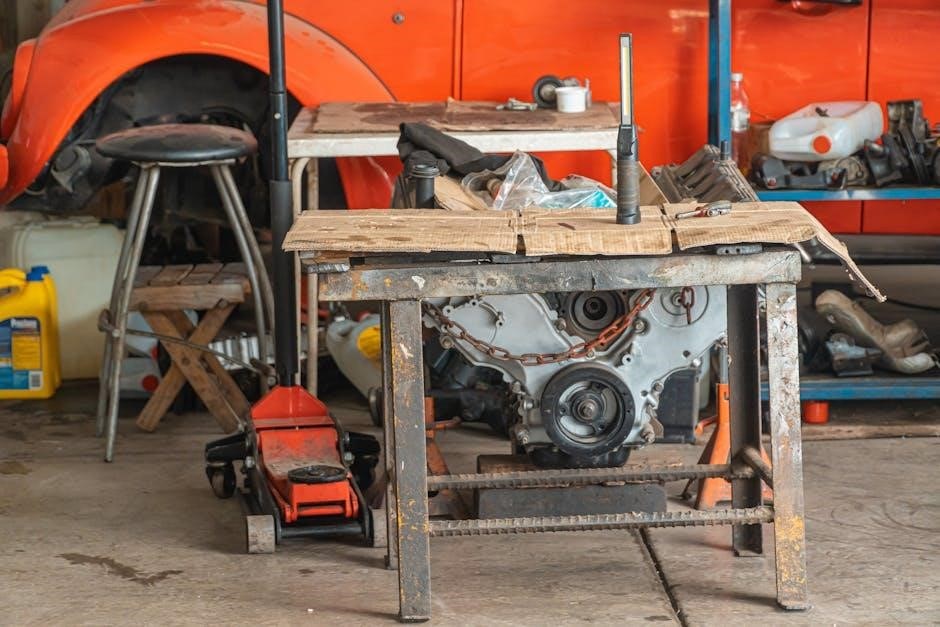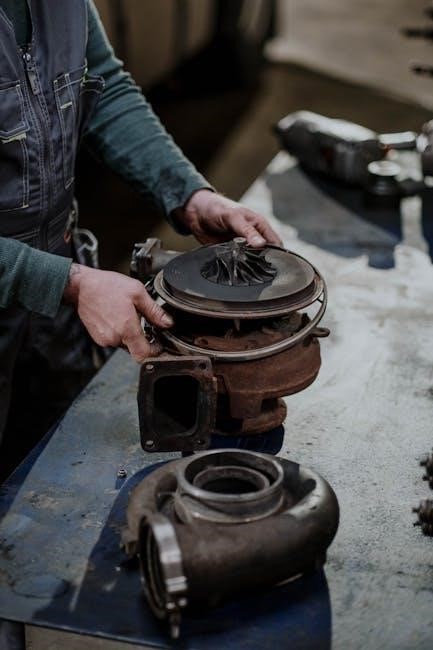
The Atlas Copco XAS 185 Parts Manual is a comprehensive guide for maintaining and repairing your compressor. It includes detailed diagrams, part numbers, and repair procedures to ensure optimal performance and longevity;
Overview of the Atlas Copco XAS 185 Compressor
The Atlas Copco XAS 185 is a portable, diesel-powered air compressor designed for demanding industrial and construction applications. Known for its efficiency and reliability, this compressor delivers high-quality compressed air with minimal fuel consumption. Its robust design and compact footprint make it ideal for use in remote or challenging environments. The XAS 185 features advanced cooling systems to ensure optimal performance in high-temperature conditions. With a focus on durability and ease of maintenance, this compressor is widely used in industries such as construction, mining, and oil and gas. Its portability and versatility allow it to meet the needs of various projects, making it a trusted choice for professionals requiring consistent and reliable compressed air solutions.
Importance of Using the Official Parts Manual
Using the official Atlas Copco XAS 185 parts manual is essential for ensuring proper maintenance, repair, and operation of the compressor. It provides accurate and detailed information about every component, allowing users to identify and replace parts correctly. The manual includes specific instructions, diagrams, and part numbers, reducing the risk of errors or compatibility issues. Following the official guidelines helps maintain the compressor’s performance, safety, and longevity. It also ensures compliance with manufacturer recommendations, which is critical for warranty validation and operational safety. By referencing the official manual, users can avoid costly mistakes and ensure their compressor runs efficiently and reliably over time.
Key Features of the XAS 185 Model
The Atlas Copco XAS 185 is a portable air compressor designed for high-performance applications. It features a robust design, ensuring durability and reliability in demanding environments. The compressor is equipped with a high-efficiency engine and advanced cooling systems, which optimize performance and reduce operational noise. Its compact size and lightweight construction make it easy to transport and maneuver on job sites. The XAS 185 also offers excellent fuel efficiency, lowering operational costs. It includes user-friendly controls and a comprehensive monitoring system for easy operation and maintenance. Additionally, the compressor is built with high-quality components, ensuring long-term reliability and minimal downtime. These features make the XAS 185 a versatile and dependable choice for industrial and construction applications.

Safety Guidelines and Precautions
Always wear PPE, follow operational procedures, and adhere to Atlas Copco’s safety standards to minimize risks. Regular inspections and proper machine handling are essential to prevent accidents.
General Safety Precautions for Handling Compressed Air
Always wear approved safety goggles and gloves when handling compressed air systems. Ensure the compressor is turned off and pressure is relieved before maintenance. Use only Atlas Copco-approved hoses and fittings to prevent system damage. Never direct compressed air at people or flammable materials. Keep the work area well-ventilated and avoid breathing compressed air, as it may contain harmful contaminants. Regularly inspect hoses and connections for leaks or damage. Follow proper startup and shutdown procedures to avoid sudden pressure spikes. Ensure all personnel are trained in the safe operation and handling of compressed air equipment. Always refer to the Atlas Copco XAS 185 Parts Manual for specific safety recommendations.
Personal Protective Equipment (PPE) Requirements
When working with the Atlas Copco XAS 185 compressor, always wear approved safety goggles to protect against debris or compressed air leaks. Gloves are essential to prevent cuts and abrasions during maintenance tasks. Steel-toe boots should be worn to safeguard feet from heavy components. High-visibility clothing is recommended to enhance visibility in workshop environments. Ensure all PPE meets industry safety standards and is in good condition. Regularly inspect PPE for damage or wear and replace as needed. Proper PPE use minimizes risks of injury and ensures compliance with workplace safety regulations. Always consult the Atlas Copco XAS 185 Parts Manual for specific PPE recommendations tailored to your compressor model.
Safe Operating Practices for the XAS 185
Always adhere to the manufacturer’s guidelines when operating the Atlas Copco XAS 185 compressor. Ensure the machine is placed on a level, stable surface and properly secured. Before starting, inspect hoses and connections for damage or leaks. Operate the compressor within the recommended pressure range to avoid overloading the system. Avoid overheating by maintaining adequate ventilation and monitoring the temperature gauge. Never modify the compressor without authorization, as this could compromise safety and performance. Regularly inspect belts, filters, and other components for wear. Shut down the compressor immediately if unusual noises or vibrations occur. Follow proper startup and shutdown procedures to prevent sudden pressure changes. Always monitor the system for leaks or malfunctions during operation. Ensure all operators are trained and familiar with the equipment to maintain a safe working environment.

Identifying Parts and Components
The Atlas Copco XAS 185 parts manual provides detailed diagrams and descriptions to help users identify and locate components efficiently, ensuring compatibility and proper maintenance.
Major Components of the XAS 185 Compressor
The Atlas Copco XAS 185 compressor comprises several key components, including the compressor unit, diesel engine, air filter, oil system, and control panel. The compressor unit is the core of the machine, responsible for generating compressed air. The diesel engine provides the power required for operation, while the air filter ensures clean air intake. The oil system lubricates moving parts to maintain efficiency and longevity. The control panel houses essential controls and indicators for monitoring performance. Understanding these components is crucial for effective maintenance and troubleshooting. The parts manual provides detailed descriptions and diagrams to help users identify and access each part, ensuring proper functionality and safety.
Understanding the Parts Diagram
The Atlas Copco XAS 185 parts manual includes a detailed parts diagram to help users identify and locate components efficiently. This visual guide illustrates the compressor’s structure, highlighting major assemblies and their relationships. Each part is labeled with a reference number, corresponding to the parts list for easy identification. The diagram is color-coded or shaded to differentiate sections, such as the compressor unit, engine, and control panel. Users can cross-reference part numbers with the manual’s index to find descriptions, specifications, and replacement instructions. Understanding the parts diagram is essential for ordering correct replacements and performing maintenance tasks accurately. It serves as a visual roadmap, ensuring users can navigate the compressor’s components with confidence and precision.
Interpreting Part Numbers and Codes
Interpreting part numbers and codes in the Atlas Copco XAS 185 parts manual is crucial for accurate identification and ordering of components. Each part number is structured to provide specific information, such as the component type, size, and material. Codes may indicate standards, classifications, or compatibility. For example, a part number like “XAS185-ABC123” might denote the compressor model (XAS185), a specific category (ABC), and the item number (123). The manual provides a decoding guide to help users understand these structures. This ensures that users can identify the correct parts quickly and avoid mismatches. Proper interpretation is essential for maintaining compatibility and performance when replacing or servicing components. Always refer to the manual’s decoding section for clarity and accuracy.

Maintenance and Service Schedule
Regular maintenance ensures optimal performance. Schedule routine service at recommended intervals. Inspect components, replace filters, and check lubrication levels. Follow guidelines for longevity and reliability.

Recommended Maintenance Intervals
Regular maintenance is crucial for the Atlas Copco XAS 185 compressor to ensure optimal performance and longevity. The parts manual outlines specific intervals for checks and replacements. Daily checks include inspecting air filters and oil levels. Weekly, ensure all connections are secure and hoses are free of damage. Monthly, clean or replace the air filter and check the oil filter for contamination. Every 500 hours, replace the oil and oil filter, and inspect the belt for wear. Annually, perform a comprehensive service, including checking the cooling system and electrical components. Adhering to these intervals prevents breakdowns and maintains efficiency. Always consult the official manual for detailed procedures and specific recommendations tailored to the XAS 185 model.
Steps for Routine Service and Inspection
Performing routine service and inspection on the Atlas Copco XAS 185 compressor ensures reliable operation and extends its lifespan. Start by turning off the compressor and allowing it to cool. Inspect the air filter for cleanliness and replace it if necessary. Check the oil level using the dipstick, ensuring it meets the recommended level. Examine the belts for signs of wear or cracks and adjust tension as needed. Inspect hoses and connections for leaks or damage. Drain moisture from the tank to prevent rust. Finally, test the compressor at full load to ensure proper function. Always refer to the parts manual for specific guidance and safety precautions during these procedures.
Lubrication and Filter Replacement Guidelines
Lubrication and Filter Replacement Guidelines
Proper lubrication and filter maintenance are critical for the Atlas Copco XAS 185 compressor’s performance. Check the oil level daily using the dipstick and top up as needed with the recommended oil type. Change the oil and oil filter every 500 hours or as specified in the parts manual. Turn off the compressor, let it cool, and locate the drain plug for oil changes. For the air filter, inspect it every 100 hours and clean or replace it if dirty. Replace the air filter every 400-500 hours to ensure optimal airflow. Always use genuine Atlas Copco parts for replacements to maintain warranty validity and performance. Dispose of used filters and oil responsibly to avoid environmental harm.

Troubleshooting Common Issues
The Atlas Copco XAS 185 manual helps identify common issues like low pressure or overheating. Use diagnostic charts to pinpoint faults and consult repair procedures. Ensure to use genuine parts for replacements to maintain efficiency and prevent further damage.
Identifying Common Faults and Symptoms
The Atlas Copco XAS 185 Parts Manual outlines common faults and their symptoms, such as low air pressure, overheating, or unusual noises. These issues often stem from worn parts, improper lubrication, or clogged air filters. The manual provides diagnostic charts to help operators pinpoint problems quickly. For example, low pressure may indicate a faulty pressure regulator or damaged hoses, while overheating could signal a malfunctioning cooling system. Unusual noises, such as grinding or hissing sounds, may point to worn-out components like bearings or seals. Early identification of these symptoms ensures timely repairs, preventing further damage and extending the compressor’s lifespan. Always refer to the manual for accurate troubleshooting and genuine part replacements.
Diagnosing Air Pressure Problems
The Atlas Copco XAS 185 Parts Manual provides detailed guidance for diagnosing air pressure issues. Low pressure output, inconsistent airflow, or pressure drops are common symptoms. The manual recommends checking the air filter for blockages, inspecting hoses and connections for leaks, and verifying the pressure regulator’s functionality. Faulty pressure gauges or malfunctioning valves may also contribute to these problems. Users are advised to consult the troubleshooting section for step-by-step diagnostics; By identifying and addressing the root cause, operators can restore optimal performance. Always refer to the manual for accurate diagnostics and recommended repairs to ensure safety and efficiency. Regular maintenance, as outlined, helps prevent such issues from arising.
Addressing Oil and Fuel System Issues
The Atlas Copco XAS 185 Parts Manual offers detailed solutions for diagnosing and resolving oil and fuel system problems. Common issues include oil leaks, contamination, or insufficient fuel flow. Regular oil filter replacements and fuel system cleaning are essential to maintain performance. The manual recommends checking oil levels, inspecting fuel lines for blockages, and ensuring proper ventilation to prevent contamination. If oil pressure is low, replacing the oil pump or adjusting the pressure regulator may be necessary. Always follow the manual’s guidelines for oil and fuel system maintenance to prevent downtime and ensure efficient operation. Properly addressing these issues helps extend the compressor’s lifespan and maintains its reliability. Refer to the manual for specific procedures and part replacements. Regular servicing is key to avoiding costly repairs.

Replacement and Repair Procedures
Replace faulty components using genuine Atlas Copco parts for optimal performance. Follow manual instructions for disassembly, inspection, and reassembly to ensure safety and reliability.
Replacing the Air Filter
To replace the air filter on your Atlas Copco XAS 185, first ensure the compressor is turned off and the pressure is released. Locate the air filter housing, typically near the intake valve. Remove the housing cover by unscrewing it or releasing the latch, depending on the model. Carefully pull out the old filter, taking note of its orientation for proper installation. Inspect the filter for damage or excessive dust buildup. Install a new genuine Atlas Copco air filter, ensuring it is properly seated and aligned. Replace the housing cover and tighten it securely. Turn the compressor back on and check for any air leaks around the filter housing. Regular filter replacement is essential for maintaining air quality and compressor efficiency. Always refer to the manual for specific torque specifications and safety precautions to avoid damage or injury.
Changing the Oil and Oil Filter
To change the oil and oil filter on your Atlas Copco XAS 185, start by locating the oil drain plug, typically at the bottom of the compressor. Ensure the compressor is turned off and cool. Gather the necessary tools and materials, including the correct type of oil and filter as specified in the manual. Use a socket wrench to remove the drain plug and let the old oil flow into a drain pan. Replace the drain plug and tighten it to the torque specified in the manual. Next, locate the oil filter, remove it with an oil filter wrench, and dispose of it properly. Install a new oil filter by hand-tightening it after lubricating the gasket. Refill the compressor with the recommended oil, checking the level with the dipstick. Start the compressor and let it run to circulate the new oil. Check for leaks and record the maintenance in a logbook. Dispose of used oil and filters responsibly. Consult the manual or contact an authorized service center if unsure.
Replacing Worn or Damaged Parts
Replacing worn or damaged parts on the Atlas Copco XAS 185 is essential to maintain performance and prevent further damage. Always refer to the parts manual for correct part numbers and torque specifications. Start by disconnecting the compressor and ensuring it is cool. Identify the worn or damaged part using the parts diagram. Use appropriate tools to disassemble the affected component, taking care not to damage surrounding parts. Remove the old part and install the new one, ensuring proper alignment and securing it with the specified torque. Reassemble the compressor, checking for any leaks or misalignments. Test the compressor at a low load to ensure proper operation. Keep track of replaced parts and schedule follow-up inspections as needed. If unsure, consult an authorized Atlas Copco service technician for assistance.

Technical Specifications and Compatibility

The Atlas Copco XAS 185 operates at 185 CFM and 100 PSI, powered by a diesel engine. It’s compatible with various attachments and functions optimally under specified conditions.
Technical Parameters of the XAS 185
The Atlas Copco XAS 185 compressor delivers 185 CFM at 100 PSI, powered by a reliable diesel engine. It weighs approximately 2,000 lbs and measures 115x45x63 inches. Designed for durability, it features a fuel-efficient system with low emissions. The compressor operates within a temperature range of -20°C to 50°C and up to 90% relative humidity. Its robust design ensures consistent performance in demanding environments. Key parameters include a maximum pressure of 100 PSI, airflow rate of 185 CFM, and a rotational speed of 1,800 RPM. These specifications ensure the XAS 185 meets industrial air supply needs effectively while maintaining operational efficiency and reliability.
Compatibility with Accessories and Attachments
The Atlas Copco XAS 185 compressor is designed to work seamlessly with a wide range of accessories and attachments. It supports various air tools, hoses, and couplers, ensuring versatility for different applications. The compressor is compatible with Atlas Copco’s genuine parts and accessories, which are engineered to maintain optimal performance. Common attachments include aftercoolers, moisture separators, and pressure gauges. Additionally, it can integrate with generators or light towers for enhanced functionality in industrial settings. Using compatible accessories ensures reliability and extends the compressor’s service life. Always refer to the official parts manual for a full list of approved accessories to guarantee safe and efficient operation.
Operating Conditions and Limits
The Atlas Copco XAS 185 compressor is designed to operate within specific conditions to ensure reliability and performance. It is recommended to use the compressor in ambient temperatures between -20°C and 50°C to prevent overheating or damage. The unit can function at altitudes up to 3,000 meters above sea level with reduced performance at higher elevations. Ensure the compressor is protected from excessive humidity and exposure to corrosive substances. Proper ventilation is essential to maintain airflow and prevent overheating. Adhere to the specified pressure ranges and avoid overloading the system beyond its rated capacity. Regular maintenance and adherence to these limits will extend the lifespan of the compressor and ensure safe operation.

Warranty and Support Information
The Atlas Copco XAS 185 is backed by a comprehensive warranty, ensuring coverage for parts and labor under specified conditions. Dedicated support teams are available for assistance, and online resources provide updated manuals and troubleshooting guides.
Understanding the Warranty Terms
The Atlas Copco XAS 185 parts manual outlines the warranty terms for the compressor, ensuring coverage for defects in materials and workmanship. The warranty typically covers parts and labor for a specified period, provided the equipment is used under normal operating conditions and maintained according to the manufacturer’s guidelines. It is essential to review the warranty document to understand the scope, including what is covered and any exclusions. Proper documentation, such as proof of purchase and maintenance records, may be required to file a claim. The warranty may be void if the compressor is misused, modified, or repaired with non-approved parts. Understanding these terms helps ensure compliance and maximizes the benefits of the warranty coverage.
Contacting Atlas Copco Support
Contacting Atlas Copco support is essential for resolving technical queries, ordering parts, or seeking assistance with the XAS 185 compressor. The official website provides detailed contact information, including regional office phone numbers, email addresses, and online support forms. Users can also access a 24/7 support hotline for urgent issues. Additionally, the Atlas Copco website offers a “Contact Us” section where customers can submit inquiries or request callbacks. For parts-related questions, the support team can guide users through the manual or direct them to authorized distributors. Regularly updated online resources, such as FAQs and service portals, further enhance accessibility to support services. Reaching out to Atlas Copco ensures timely and professional assistance for optimal compressor performance and longevity.
Accessing Online Resources and Updates
Accessing online resources and updates for the Atlas Copco XAS 185 is straightforward through the official Atlas Copco website. The site offers a dedicated “Resources” section where users can download the latest parts manuals, service guides, and software updates. Additionally, the “Support” page provides access to FAQs, troubleshooting guides, and instructional videos. Registered users can log in to access exclusive content, including personalized support and update notifications. The website is optimized for mobile devices, ensuring convenience for users on the go. Regularly checking for updates ensures compliance with the latest technical specifications and enhances compressor performance. Atlas Copco also offers email newsletters and subscription services to keep users informed about new features, maintenance tips, and product enhancements.